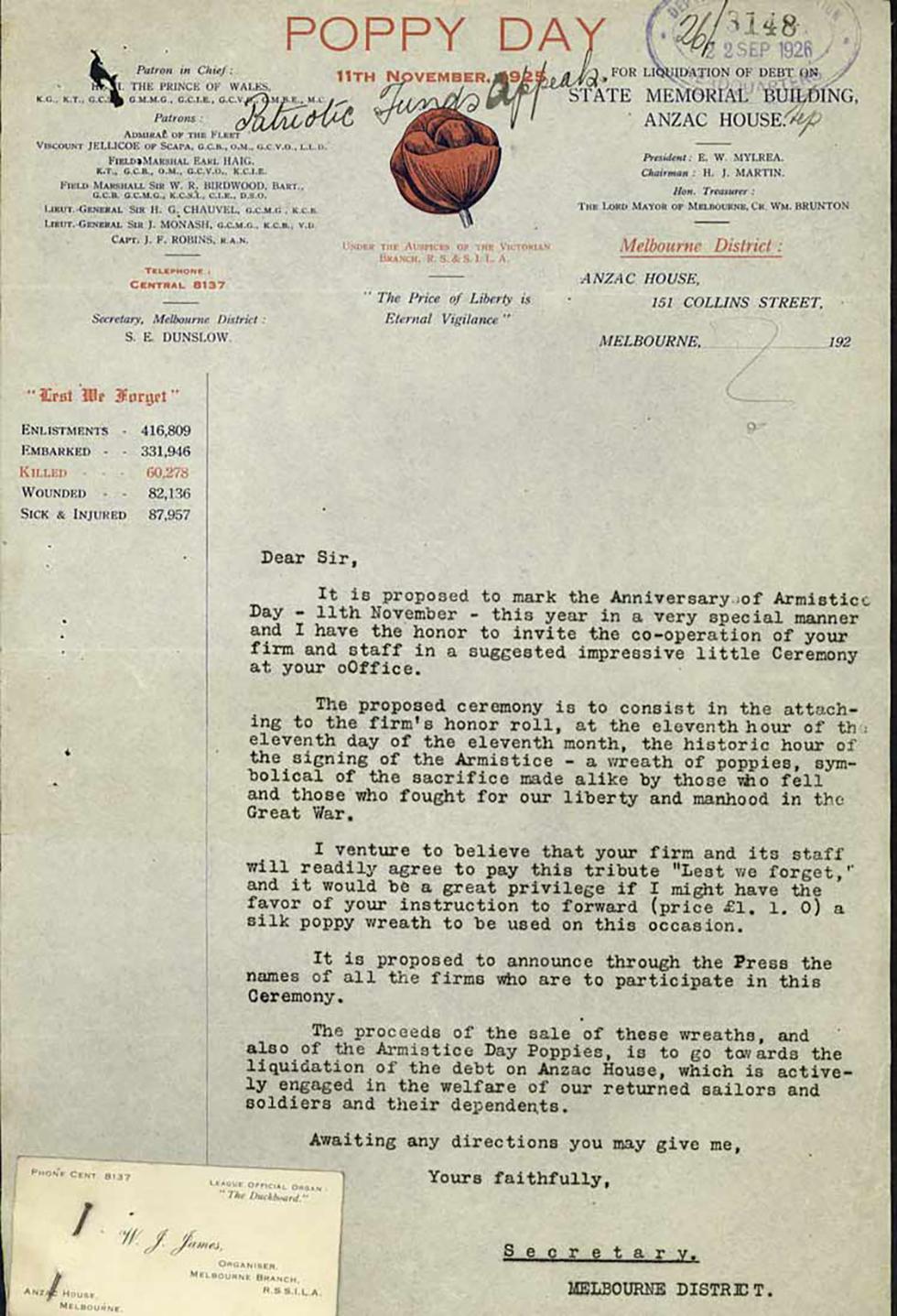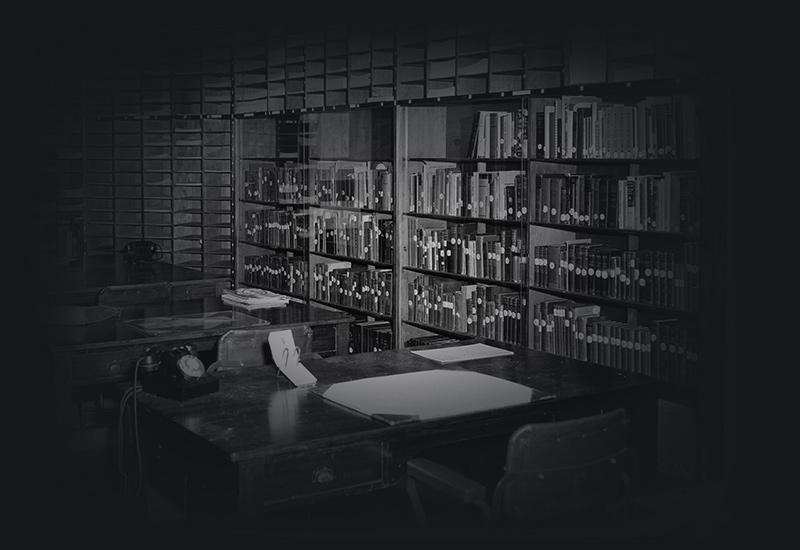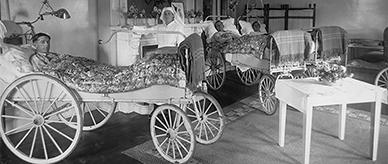


Transcript
[Letterhead top]
POPPY DAY
11th November, 1925
[Handwritten annotation under letterhead]
Patriotic Funds Appeals.
[Letterhead left side]
Patron in Chief:
H.R.H. THE PRINCE OF WALES
K.G., K.T., G.C.S [illegible] G.M.M.G, G.C.I.E., G.C.V.S., C.M.B.E., M.C.
Patrons:
ADMIRAL OF THE FLEET
VISCOUNT JELLICOE OF SCAPA, G.C.B., O.M., G.C.V.O., L.L.D.
FIELD MARSHAL EARL HAIG, K.T., G.C.B., O.M., G.C.V.O., K.C.I.E.
FIELD MARSHAL SIR W. R. BIRDWOOD, BART., G.C.B., G.C.M.G., K.C.S.I., C.I.E., D.S.O.
LIEUT.-GENERAL SIR H. G.CHAUVEL, G.C.M.G., K.C.B.
LIEUT.-GENERAL SIR J. MONASH, G.C.M.G., K.C.B., V.D.
CAPT. J. F. ROBINS, R.A.N.
TELEPHONE:
CENTRAL 8137
Secretary, Melbourne District:
S. E. DUNSLOW
“Lest we forget”
ENLISTMENTS 416,809
EMBARKED 331,946
KILLED 60,278
WOUNDED 82,136
SICK & INJURED 87,957
[Letterhead centre]
UNDER THE AUSPICES OF THE VICTORIAN BRANCH, R. S. & S. I. L. A.
“The Price of Liberty is Eternal Vigilance”
[Stamp in top right corner]
DEP [illegible] ION HEADQUARTERS
26/3148
22 SEP 1926
[Letterhead right side]
FOR LIQUIDATION OF DEBT ON STATE MEMORIAL BUILDING, ANZAC HOUSE
President: E. W. MYLREA.
Chairman: H. J.MARTIN.
Hon. Treasurer: THE LORD MAYOR OF MELBOURNE, CR. WM. BRUNTON
Melbourne District:
ANZAC HOUSE,
151 COLLINS STREET,
MELBOURNE, ...............192
[Body of letter]
Dear Sir,
It is proposed to mark the Anniversary of Armistice Day – 11th November – this year in a very special manner and I have the honor to invite the co-operation of your firm and staff in a suggested impressive little Ceremony at your Office.
The proposed ceremony is to consist in the attaching to the firm's honor roll, at the eleventh hour of the eleventh day of the eleventh month, the historic hour of the signing of the Armistice – a wreath of poppies, symbolical of the sacrifice made alike by those who fell and those who fought for our liberty and manhood in the Great War.
I venture to believe that your firm and its staff will readily agree to pay this tribute “Lest we forget,” and it would be a great privilege if I might have the favor of your instruction to forward (price £1. 1. 0) a silk poppy wreath to be used on this occasion.
It is proposed to announce through the Press the names of all the firms who are to participate in this Ceremony.
The proceeds of the sale of these wreaths, and also of the Armistice Day Poppies, is to go towards the liquidation of the debt on Anzac House, which is actively engaged in the welfare of our returned sailors and soldiers and their dependants.
Awaiting any directions you may give me,
Yours faithfully,
Secretary.
MELBOURNE DISTRICT.
[Business card stapled to letter]
Phone Cent. 8137
LEAGUE OFFICIAL ORGAN:
“The Duckboard.”
W.J.James,
Organiser,
Melbourne Branch,
R.S.S.I.L.A.
Anzac House, Melbourne.
About this record
This is a proforma letter from the secretary of the Melbourne district of the Returned Sailors’ and Soldiers’ Imperial League of Australia (RSSILA). It seeks financial support for their headquarters at Anzac House through the purchase of poppy tributes to mark Armistice Day. The letterhead reads ‘Poppy Day, 11 November, 1925’. The writer requests that the business owner who receives the letter should celebrate the anniversary of the signing of the Armistice by purchasing a wreath of poppies to attach to the firm’s honour roll.
Educational value
- This letter represents an early use of a red poppy as a symbol of the sacrifice of lives in war. The corn poppy (Papaver rhoeas) was common in the fields of France and Belgium and came to be known as the ‘Flanders’ poppy. It was first described as the flower of remembrance by Canadian doctor and poet Lieutenant Colonel John McCrae in his poem, ‘In Flanders Fields’, about the First World War. The first silk poppies, made in France, were sold in Australia on Armistice Day 1921.
- This letter is an example of postwar efforts to assist the thousands of returned servicemen, many of whom were incapacitated by the war. Disability pensions and medical treatment after discharge were often inadequate. Many returned soldiers suffered emotional disorders such as anxiety, nightmares and insomnia. Just as they had done for serving personnel during the war effort, volunteer organisations rallied to support the veterans. The scale of financial and medical support the Australian Government needed to provide veterans was huge, and led to the establishment of the Repatriation Department in 1918.
- The RSSILA was formed in 1916 to support serving and ex-service defence force members and their families. The organisation evolved out of the camaraderie and mateship of the forces. It was set up to provide the returned servicemen and their dependants with assistance, including pensions, medical attention, homes and suitable employment. The RSSILA is now known as the Returned and Services League (RSL) of Australia.
- The letterhead states that the fundraising appeal is for ‘Liquidation of debt on State Memorial Building, Anzac House’, with the headquarters of the RSSILA listed as 151 Collins Street, Melbourne. It became traditional for all buildings which operated as headquarters for the RSSILA (and now the RSL) to be called ‘Anzac House’. The RSSILA opened their new Anzac House headquarters at 4–6 Collins Street in 1938.
- The RSSILA letterhead bears the names of distinguished patrons such as Field Marshall Earl Haig, General Sir John Monash, Field Marshall Sir William Birdwood and HRH The Prince of Wales, who lent their support to the war-veteran community. Field Marshall Haig, the British Commander-in-Chief, organised the British Legion to support British ex-servicemen. General Monash was a much-respected Australian general in World War I and remained active in veteran communities after his retirement from the army.
- The poppy is always worn on 11 November, Remembrance Day, which is one of two main annual war service commemorations. Remembrance Day, also called ‘Poppy Day’ and ‘Armistice Day’, was first held in 1919 to mark the anniversary of the signing the Armistice that formally ended the First World War, at the 11th hour of the 11th day of the 11th month in 1918. Anzac Day on 25 April, first celebrated in 1916, has become Australia’s foremost day of war commemoration.
Acknowledgments
Reproduced with permission from Heidelberg Repatriation Hospital and Returned & Services League of Australia (Victorian Branch)
Learning resource text © Education Services Australia Limited and the National Archives of Australia 2010.
Need help with your research?
Learn how to interpret primary sources, use our collection and more.

